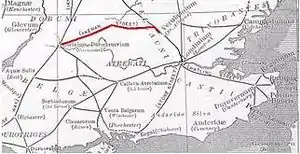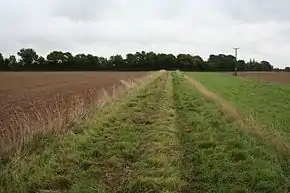Akeman Street
Akeman Street is a Roman road in southern England between the modern counties of Hertfordshire and Gloucestershire. It is approximately 117 kilometres (73 mi) long and runs roughly east–west.[1]
| Akeman Street | |
|---|---|
 Roman roads in south east England with Akeman Street in red | |
 Akeman Street north of Woodstock, here part of the Oxfordshire Way | |
| Route information | |
| Length | 117 km (73 mi) |
| Time period | Roman Britain |
| Margary number | 16[1] |
| Major junctions | |
| From | Verulanium (St Albans) |
| To | Corinium Dobunnorum (Cirencester) |
| Location | |
| Country | United Kingdom |
| Counties | Hertfordshire, Buckinghamshire, Oxfordshire, Gloucestershire |
| Road network | |
Akeman Street linked Watling Street just north of Verulamium (near modern St Albans) with the Fosse Way at Corinium Dobunnorum (now Cirencester). Evidence suggests that the route may well have been an older track, metalled and reorganised by the Romans.[2] Its course passes through towns and villages including Hemel Hempstead, Berkhamsted, Tring, Aylesbury, Alchester (outside modern Bicester), Chesterton, Kirtlington, Ramsden and Asthall.[3]
Parts of the A41 road between Berkhamsted and Bicester use the course of the former Roman road, as did the Sparrows Herne turnpike between Berkhamsted and Aylesbury. A minor road between Chesterton and Kirtlington also uses its course. Other parts are in use as public footpaths, including a 6-mile (10 km) stretch between Tackley and Stonesfield that is part of the Oxfordshire Way.
Name
The name Akeman is derived from Aquamannia – an earlier name for Bath, Somerset.[lower-alpha 1][lower-alpha 2] The name element Aqua is from the Roman name for Bath, Aquæ Sulis ("the waters of Sulis").[lower-alpha 3] The name element mannia is from Old English mannian ("to man, garrison").[lower-alpha 4][lower-alpha 5][lower-alpha 6]
The toponym for Akeman Street might be:
- Roman road to Aquamannia
- Roman road to Bath[lower-alpha 7]
References
Notes
- ...the Roman spa town of Aquæ Sulis, later Aquamannia...[4]
- The names Achamanni and Aquamania were recorded on charters for Edgar, King of England, from 965 to 972.[5]
- Wiktionary : Latin <Aquæ>
- " water ".
- Wiktionary : Old English <mannian># "to man, garrison".
- Old English < mannian > "to man, garrison".[6]
- See also Roman Britain > Establishment of Roman rule > ...For much of the history of Roman Britain, a large number of soldiers were garrisoned on the island.
- ...literally, the road to Bath; the Roman spa town of Aquæ Sulis, later Aquamannia...[7]
Citations
- Davies 2002, p. 169
- Salzman, L.F. (1939). "Romano-British remains: Roads". A History of the County of Oxford: Volume 1. Victoria County History, London. pp. 271–281. Retrieved 15 February 2019.
- Copeland, Tim (2009). Akeman Street Moving Through Iron Age and Roman Landscapes. History PressLtd. ISBN 978-0-7524-4732-2.
- Adams 2017, pp. 44–45.
-
- "Aquæ Sulis to Aquæmann". Building History. Retrieved 2 May 2023.
- Clark Hall 1916, p. 422.
- Adams 2017, pp. 44 45.
Sources
- Adams, Max (2017). Aelfred's Britain: War and Peace in the Viking Age. Head of Zeus. ISBN 9781784080310.
- Copeland, Tim (2009). Akeman Street Moving Through Iron Age and Roman Landscapes. History PressLtd. ISBN 978-0-7524-4732-2.
- Davies, Hugh (2002). Roads in Roman Britain. Stroud: Tempus. ISBN 9780752425030.
- Clark Hall, John Richard (1916). A Concise Anglo−Saxon Dictionary, Second Edition. The Macmillan Company.